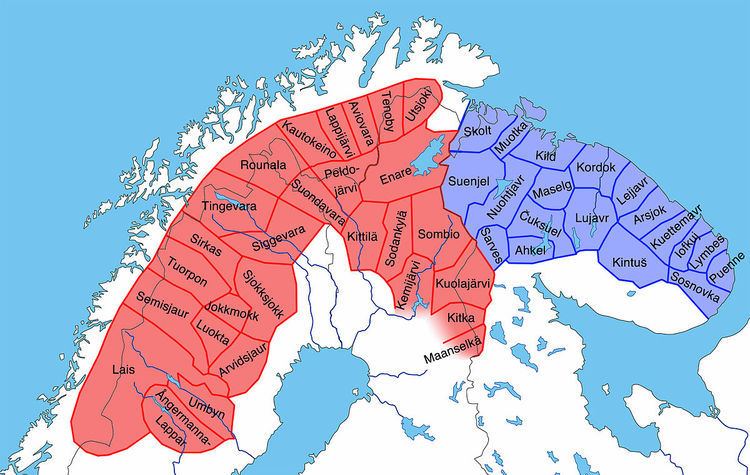 | ||
The siida is a Sami local community that has existed from time immemorial. A siida (in different Sami languages cearru, siida, sita, kite), or a "reindeer pastoralistic district," is a Sami reindeer foraging area, a group for reindeer herding and a corporation working for the economic benefit of its members. The reindeer herding siida has formed as an adaptation of ancient siida principles to large-scale nomadic reindeer herding. It is termed a sameby ("Sami village") in Swedish law, reinbeitesdistrikt ("reindeer pasture district") in Norwegian law, and paliskunta in Finnish law. The pastoralistic organisation differs slightly between countries, except in Russia, where kolkhoz has replaced these earlier organisations.
In Sweden, membership in a siida follows "pastoralistic rights" based on statute of limitations, and is limited to individuals of Sami descent. These rights also include hunting and fishing for profit. There are 33 mountain siidas, 10 forest siidas and 8 concession siidas, divided by historical extent, summer and winter pasture usage, etc. Membership is required to practice pastoralistic rights. This is required for reindeer ownership as well, except in concession siidas, where even non-members can own "serve reindeers", served by siida members who receiving concession to pasture lands in payment. This custom originates in older conventions when reindeer were used by settled local populations in daily life. The economic activity in present-day siidas is limited to profit from pastoralistic rights. In addition to the geographical and economic nature of the siida, it also ties the members together culturally and socially.
Siidas in Sweden split Sami people into two groups. Membership is essentially limited to those whose ancestors were nomads before 1886, barring the majority of Swedish Sami from membership in a siida.
In Norway, pastoralistic activity requires membership in a unit (driftsenhet), corresponding to a reindeer herd. The rights to conduct pastoralism are based on statute of limitations and limited to individuals of Sami descent.
Still, the Sami siida had not, until recently (2007), been legally acknowledged by Norwegian national authorities. Instead, the authorities maintained their own construction of reindeer herding districts. The siida, and its use of Sami traditional herding knowledge, has on the other hand been living alongside, and often in conflict with, official accounts and decisions. The recently achieved legal acknowledgement of siida in Norway must result in recognition of its autonomous processes of knowledge as well as recognition of its land rights.
In Finland and Russia, pastoralistic activity is not limited to ethnic Sami. In Finland, reindeer herding is also practiced by Finns (non-Samis). There are 56 paliskuntas, of which 13 in the extreme north of Lapland constitute the Sami area. However, reindeer herding has a more prominent economic role in the local communities of the north. Siidas are governed like stock companies, where the reindeerholders elect a board of directors and a chief executive officer (poroisäntä, "reindeer master") every three years, voting with as many votes as they have reindeer. In Russian arctic peoples were forcably relocated to Kolchoz'es (collective communities) by the state between 1927-1940. The Sami were moved to Kolchoz'es in the pogost Kamensky, Iokangsky, Kildinsky, Lovozersky and Voronensky.
There are many other aspects of the traditional institution of siida and the siida system beyond the main issues of land rights and resource management. One of these aspects is the type of knowledge embedded in siida practices and the siida's everyday dealings with the local environment. The use, and therefore the protection, of traditional Sami reindeer herding practices and knowledge are closely related with the viability of the siida system. Siida principles are ancient in origin. The main elements of the siida are the individuals (in Sami siidda olbmot); the husbandry units (baikedoalut); the collective and the herding unit (siidadoallu); the siida territory, resources, and infrastructure (orohagat/siidavuoddu); and the semi-nomadic or nomadic lifestyle in accordance with the flow of the seasons (johtaladdan).
Today's Sámi communities in Sweden
The mountain Sámi villages: Könkämä, Lainiovuoma, Saarivuoma, Talma, Gabna, Leavas, Girjas, Báste, Unna Tjerusj, Sirges, Jåkkåkaskatjiellde, Tuorpon, Luokta Mavas, Semisjaur-Njarg, Svaipa, Grans, Rans, Ubmeje tjeälddie, Vapstens, Vilhelmina norra, Vilhelmina södra, Frostvikens norra, Ohredahke, Raedtievaerie, Jiingevaerie, Jovnevaerie, Njaarke, Kall, Handölsdalens, Tåssåsens, Mittådalens, Ruvhten sijte, Idre
Forest Sámi villages: Vittangi, Gällivare, Serri, Udtja, Ståkke, Maskaur, Västra Kikkejaur, Östra Kikkejaur, Mausjaur, Malå
Concession Sámi villages: Muonio, Sattajärvi, Tärendö, Korju, Pirttijärvi, Ängeså, Kalix, Liehittäjä
